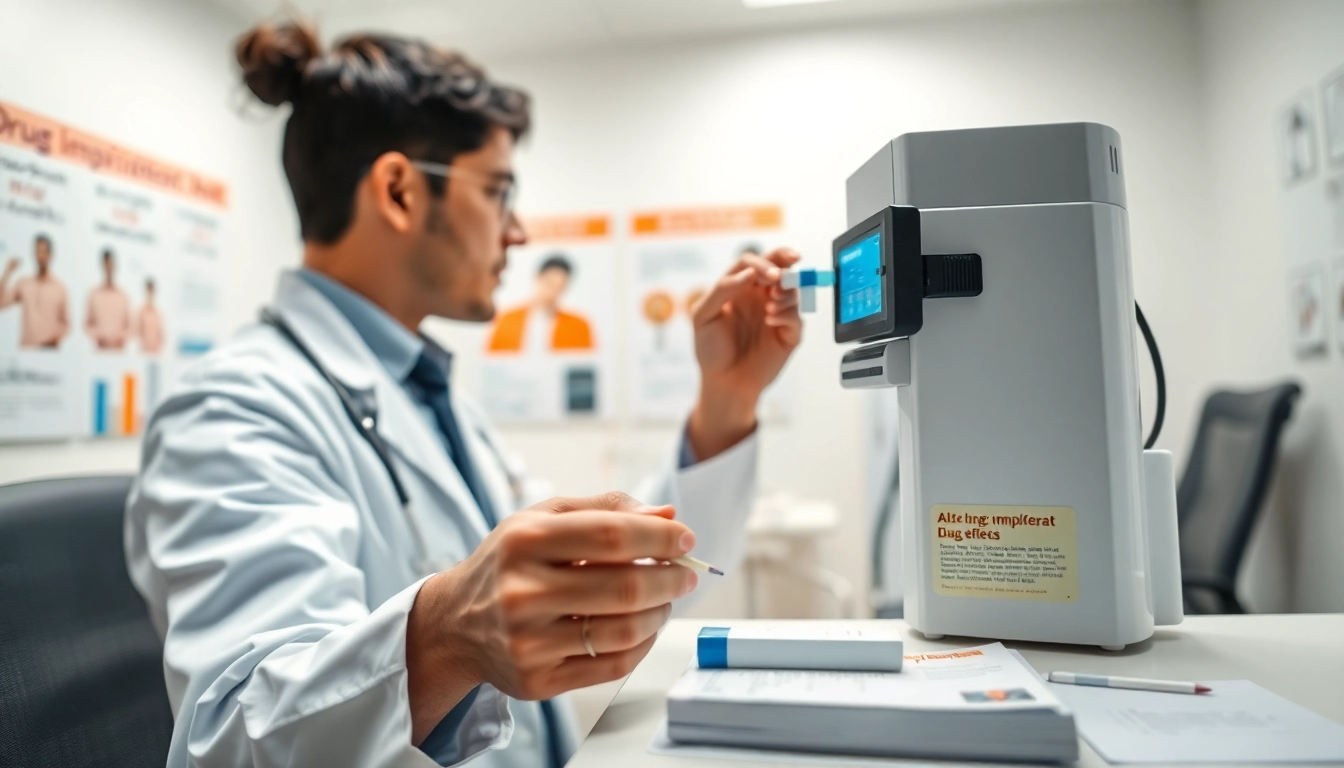What is a Drug Impairment Test?
Definition and Purpose of Drug Impairment Tests
A drug impairment test is a method utilized to determine the level of an individual’s ability to perform tasks safely and effectively while under the influence of drugs. The primary purpose of these tests is to ascertain whether the impairment results from the consumption of substances, potentially affecting decision-making, coordination, and reaction times. The protocol for these tests often involves a combination of behavioral assessments, physical coordination tasks, and specific physiological tests that assess observable impairment markers.
Why Drug Impairment Testing is Critical in Safety-Sensitive Jobs
In safety-sensitive jobs, such as those in transportation, construction, and healthcare, the stakes are significantly high. Here, even minor impairments due to substance use could lead to catastrophic accidents, injuries, or fatalities. Implementing drug impairment tests helps employers protect their workforce and the public by ensuring individuals who are under the influence are identified promptly. Studies have shown that workplaces that enforce rigorous drug testing policies report lower accident rates, enhanced productivity, and improved workplace morale.
Different Types of Drug Impairment Tests
Drug impairment testing is not a one-size-fits-all approach. There are several types of tests designed to detect impairment based on different substances including oral fluid tests, urine tests, blood tests, and even advanced technologies like breathalyzers for cannabis. Understanding the various types of drug impairment tests allows organizations to choose the most effective approach for their specific needs.
Types of Drug Impairment Tests Explained
Urine Testing vs. Blood Testing for Impairment
Urine testing is one of the most widely used methods for detecting drug impairments due to its simplicity, non-invasiveness, and cost-effectiveness. However, it primarily indicates past usage rather than current impairment, as drug metabolites can linger in the body for days or even weeks, depending on the substance.
Blood testing, on the other hand, offers a more accurate reflection of current impairment since it measures the actual levels of drugs in the bloodstream at the moment of testing. This method, while more invasive and expensive, is often seen as the gold standard for assessing impairment due to substances such as alcohol and narcotics. Many workplaces that require immediate assessments of fitness for duty may prefer blood testing to ensure the safety of operations.
Saliva Tests: Fast Results and Their Usage
Saliva testing has gained popularity for its quick results and ease of administration. This method can detect recent drug use, often within a few hours to a couple of days of ingestion, making it an effective tool for workplaces that require immediate testing, such as those in safety-sensitive positions. Additionally, saliva tests are less invasive and can be conducted discreetly on-site, making them an attractive alternative to urine and blood tests.
Innovative Technologies in Drug Impairment Testing
As technology evolves, so do the methods we use for testing drug impairment. Innovations such as eye-tracking technology, field sobriety test enhancements, and mobile testing units equipped with advanced sensors have emerged. These technologies enable more efficient assessments and can potentially provide real-time results, enhancing workplace safety measures. Additionally, companies like Tobii are exploring virtual reality integrations to assess impairment more effectively, which may redefine the testing landscape in the future.
Understanding the Impairment Levels
What Constitutes Drug Impairment?
Drug impairment is characterized by a measurable decline in cognitive and motor skills brought on by substance use. Factors such as the type of substance, dosage, duration of use, and individual user characteristics (such as tolerance and metabolism) all play significant roles in determining impairment levels. For instance, cannabis impairment may present differently than alcohol impairment, necessitating distinct assessment methods tailored to each substance’s specific effects on the body and mind.
Interpreting Test Results Accurately
Accurate interpretation of drug test results is crucial for effective decision-making in safety-sensitive environments. Results must be contextualized with an understanding of the specific drug’s pharmacokinetics and effects on human performance. Misinterpretation can lead to wrongful accusations or overlooking true impairment cases. Employers should ensure that those responsible for interpreting results are adequately trained and familiar with relevant substance influence characteristics.
The Role of THC and Other Substances in Impairment
Tetrahydrocannabinol (THC), the primary psychoactive component of cannabis, presents unique challenges in drug impairment testing. As legalization of cannabis spreads, understanding its different effects—particularly concerning impairment—becomes increasingly essential. Unlike alcohol, where specific blood alcohol concentrations can reliably indicate impairment, THC levels do not correlate straightforwardly with impairment levels. Employers and law enforcement are increasingly seeking reliable metrics for THC and its impact on performance to ensure safety in environments that have adopted more lenient cannabis policies.
Challenges in Drug Impairment Testing
Legal and Ethical Considerations
The legal landscape surrounding drug impairment testing is complex and constantly evolving, particularly with advancements in cannabis legalization. Employers must navigate a web of state and federal laws concerning drug testing in the workplace. Ethical considerations also play a critical role; organizations must balance safety with employee rights regarding privacy and discrimination. Clear policies and open communication can help mitigate legal risks and establish fairness in the testing process.
Potential Errors and Misinterpretations in Testing
While drug testing is a valuable tool, it’s important to acknowledge that errors can occur. False positives and negatives, as well as misinterpretation of results, may threaten the validity of testing programs. Implementing confirmatory tests, upholding chain-of-custody procedures, and providing comprehensive training for personnel involved in testing processes are essential steps to reduce these errors.
Emerging Trends and Solutions to Testing Challenges
To address the challenges in drug impairment testing, a number of emerging trends are gaining traction. One key trend is the development of on-site testing kits that provide immediate feedback, reducing the time between testing and results. Another solution is the focus on creating reference materials and test protocols standardized across sectors, which can help ensure consistency and reliability in testing. Technologies that incorporate AI to analyze patterns in impairment and substance use are also promising avenues for enhancing testing efficacy.
Implementing Drug Impairment Testing in the Workplace
Best Practices for Employers
For organizations looking to implement or improve their drug impairment testing programs, several best practices can enhance effectiveness. Firstly, conducting comprehensive training for employees on the testing processes and the substances involved is vital. Secondly, employers should ensure that testing methods align with current best practices and scientific findings, rather than adopting outdated technologies or methodologies. Lastly, regular evaluations of testing policies are essential to adapt to changing legal frameworks and societal attitudes.
Creating an Effective Drug Testing Policy
To foster a drug-free workplace while maintaining respect for employee rights, organizations must develop clear, effective drug testing policies. These policies should articulate the types of tests administered, the circumstances under which testing occurs, and the consequences for both passing and failing tests. Involving legal counsel in drafting the policy can help mitigate risks associated with legal exposure and workplace contention.
Measuring the Effectiveness of Drug Impairment Tests
Lastly, tracking and measuring the effectiveness of drug impairment tests is crucial to maintaining workplace safety and productivity. Organizations should establish metrics that truly reflect the success of their testing programs, such as reductions in workplace accidents, improved employee performance, and compliance with safety regulations. Regular audits and assessments can help identify areas for improvement and guide future decisions regarding testing protocols.



